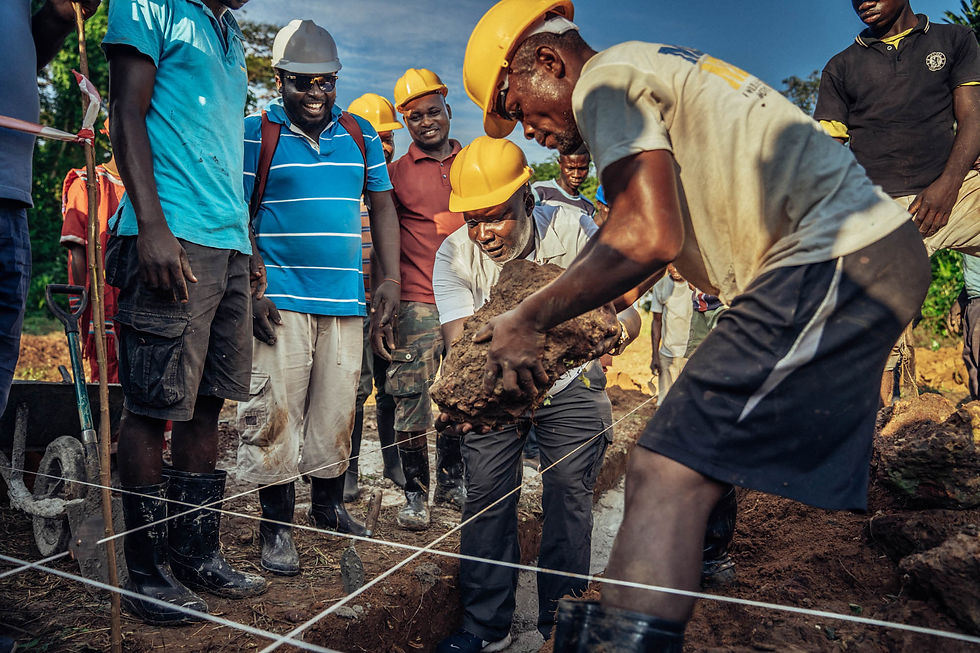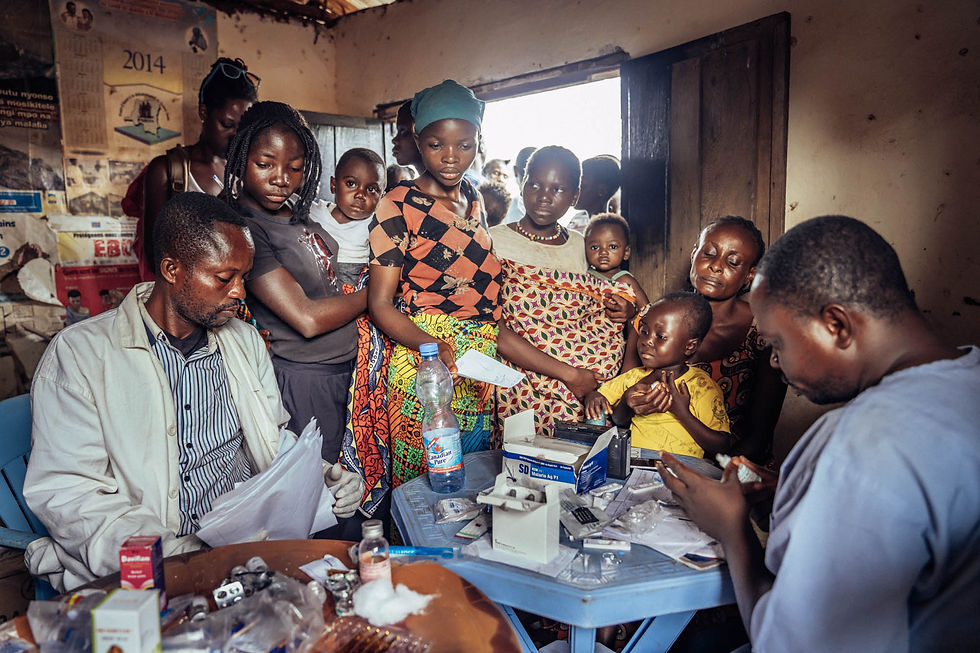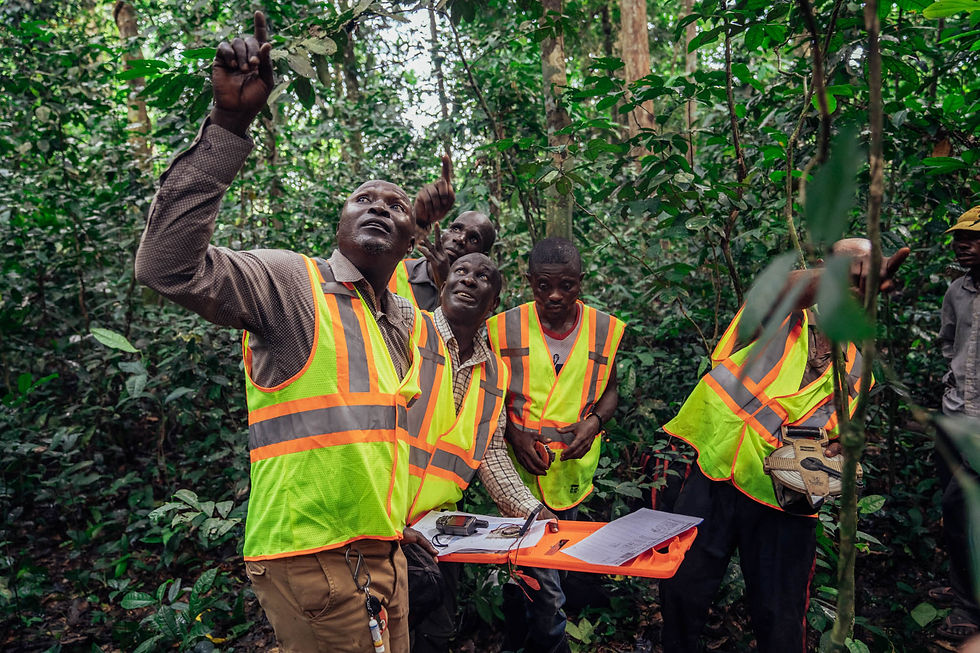The hospital and clean water have greatly improved health in our village, and we are looking forward to building a new school soon. We also appreciate that Wildlife Works is committed for the long term, not like some others who just donate individual items, like our old broken water pump, and then leave.
WATCH
>50k
COMMUNITY
PARTNERS

300k
HECTARES
OF FOREST PROTECTED

3
ENDANGERED
SPECIES PROTECTED

2.8m
tCO2e EMISSIONS
AVOIDED PER YEAR

POACHER TO PROTECTOR
The Mai Ndombe REDD+ Project in the DRC employs over 20 eco-guardians, many of whom are former poachers.
ABOUT THE MAI NDOMBE REDD+ PROJECT
The Mai Ndombe REDD+ Project protects 300,000 hectares of critical bonobo and forest elephant habitat within the world’s second-largest intact rainforest and some of the most important wetlands on the planet, the Congo Basin.
Chief Nkonsango Ndala
IBALI CARBON COMMITTEE REPRESENTATIVE WILDLIFE WORKS MAI NDOMBE REDD+ PROJECT
OVERVIEW
Covering nearly 300,000 hectares of tropical rainforest and one of the most important wetlands in Africa, the Mai Ndombe REDD+ project partners with over 50,000 local community members to stop deforestation and co-create new economic opportunities. With community self-governance and sustainable job creation at the heart of the project’s strategy, the Mai Ndombe REDD+ project drives direct investments to community-determined projects relating to health, education, clean water, sustainable agriculture and other income-generating opportunities. By stopping deforestation and forest degradation, this project protects critical habitat for endangered species such as forest elephants and bonobos.

MAI NDOMBE
DEMOCRATIC REPUBLIC OF THE CONGO
REDD+ PROJECT SPECIFICS
START DATE: MARCH, 2011
DURATION: 30 YEARS
PROJECT TYPE: AVOIDED DEFORESTATION REDD+
METHODOLOGY: VM0009
REGISTRY: VERRA
THIRD-PARTY VERIFIED ☑
PROJECT FAQ
FOR DETAILS INCLUDING THE PROJECT BASELINE AND REFERENCE AREA.
READ THE FULL PROJECT FAQ FOR DETAILS INCLUDING THE PROJECT BASELINE AND REFERENCE AREA.
IMPACT HIGHLIGHTS










10 FISH PONDS CONSTRUCTED AND NEW CASSAVA STRAINS INTRODUCED FOR IMPROVED FOOD SECURITY
OVER 300 LOCAL JOBS CREATED
11 SOLAR POWERED, SUSTAINABLE CLEAN WATER WELLS
12 SCHOOLS BUILT OR RENOVATED
18 MOBILE HEALTH CLINICS AND ONE HOSPITAL ESTABLISHED


MAI NDOMBE REDD+ PROJECT CONTRIBUTES TO 13 SDGs
The Mai Ndombe project area is home to 50,000 forest community members dispersed across more than 28 villages.
The majority of the villages are home to people who identify as Bantu. Bantus are pastoralist migrants, who settled around Lake Mai Ndombe many generations ago. There is one village outside of the project area but in the project zone that is home to the Batwa, more widely known under the discriminatory name “pygmies.” The Batwa are the original Indigenous stewards of the forest.
Due to centuries of colonialism and exploitation, all of the community members within the project area and project zone have been disenfranchised from their economic and political empowerment and are some of the most marginalized communities in the world. They are looking for new strategies to meet their basic needs while still living in harmony with the forest that they have strong cultural and spiritual connections to.
ARTICLE 01
RETURN OF THE FOREST ELEPHANTS
For years, the landscape in the project area was mostly devoid of wildlife. But now, the forest and wildlife is coming back to life thanks to the REDD+ project.
ARTICLE 02
AN INTERVIEW WITH
MATTHIEU BOLAA
Mathieu “De la Forêt” Bolaa is the Head of Biodiversity for Wildlife Works in the DRC, and has personally witnessed the return of elephants to the area.
COMMUNITY STORIES

EDUCATION
Learn more
With earned carbon revenue, communities are investing in building educational facilities, which were previously non-existent or insufficient in most villages across the project zone. A lack of education in the region has been directly correlated with increased deforestation and negative health outcomes. In total, 32 schools are planned to be built throughout the lifetime of the project. Carbon revenue also covers uniforms, school fees, teachers' salaries, and national exam fees.

INCREASING FOOD SECURITY
Learn more
Lake Mai Ndombe is one of the most biologically unique lakes in the world. Unlike other large African lakes, dominant fish species have never been introduced, resulting in a habitat rich in endemic species. But over the past few decades, the supply of fish has dramatically dwindled due to unsustainable fishing practices. Community members have invested carbon revenue into sustainable fish ponds to strengthen food security and eventually repopulate the lake.

QUALITY HEALTHCARE
Learn more
Improved healthcare is one of the most important project activities that communities in the Mai Ndombe REDD+ invest their carbon revenue into. Maternal mortality rate is one of the highest in the world, and over ⅓ of children under 5 are malnourished and many are at high risk from malaria and measles outbreaks. A new hospital and rapid response mobile health clinics are revolutionizing access to quality health care.

COMMUNITY GOVERNANCE
Local Development Committees have been established as key structures for local governance within the project area. Project activities are selected in consultation with the local communities as well as other key stakeholders and officials from different levels of government.

CLEAN WATER
Learn more
With earned carbon revenue from forest protection, communities have invested in a portable drilling rig to revolutionize access to clean water.

CONSERVATION AGRICULTURE
Learn more
Cassava is a critical food staple for millions of people across the DRC, but its productivity is threatened by various pests and diseases.
Locally-hired employees conduct demonstration gardens, agroforestry and conservation farming training to increase access to information for local community members so that they can improve their crop yields in sustainable ways.

THE COMMUNITY PARTNERS
.webp)
° Pan paniscus
BONOBOS
Bonobos are 98.7% related to humans, making them one of our closest relatives. They are only found in the Democratic Republic of the Congo, and our project site in Mai Ndombe is an important refuge for this endangered species. The main threats to bonobos are habitat loss and the illegal wildlife trade markets. Bonobos are hunted for their meat or to be sold as pets. Due to disturbance from the previous logging company, there were only 20-30 bonobos when we first started our project. Today, there is evidence that hundreds of bonobos use this habitat. This is significant to the survival of the species as a whole.

° Loxodonta cyclotis
FOREST ELEPHANT
Forest elephants are the smaller and more reclusive cousin of the larger Savannah elephant. It was only in 2021 that forest elephants were declared a separate species. As mega-gardeners of the jungles, Forest elephants are some of our best warriors in the fight against climate change. By eating smaller plants, elephants reduce competition for soil nutrients and light, allowing larger trees to flourish and capture even more CO2 out of the atmosphere. Scientists hypothesize that the presence of a mega-herbivore is why the Congo Basin sequesters double the amount of carbon than the Amazon rainforest, even though it is only half the size. The main threats to forest elephants are climate change, habitat loss, poaching for ivory, and retaliatory killings from human-elephant conflict. Prior to Wildlife Works’ conservation project, forest elephants hadn’t been seen in the area in decades. Today, the local population has recovered and the project area now supports close to a 100 forest elephants.

° Smutsia gigantea
GIANT PANGOLIN
Pangolins, the scaly, long-nosed anteaters of the tropics, are some of the most unique mammals in the world. By feeding on termites, they help to protect trees and maintain ecological balance. Unfortunately, they are also the most trafficked animal in the world, as their scales are used for traditional East-Asian medicines.

° Hippopotamus amphibius
HIPPOPOTAMUS
After elephants and rhinos, hippos are the third largest land mammal on our planet; a male hippo can weigh as much as three compact cars. Hippos can be extremely territorial and aggressive, and on average, kill 500 people per year in Africa (about twice the number of people killed by lions). Despite their impressive stature and aggressive predisposition, their populations are decreasing across Sub-Saharan Africa, most rapidly in the DRC. The main threats to hippos are habitat loss and hunting for their meat and teeth. Wildlife Works, in partnership with local communities, is creating strategies for human-wildlife coexistence.
FOCAL
WILDLIFE SPECIES
Camera trap footage of bonobos (pan paniscus) at a watering hole at the Mai Ndombe REDD+ project
Camera trap footage of forest elephants (Loxodonta cyclotis) at the Mai Ndombe REDD+ project in the DRC
The forest - spanning 740,000 acres - is primarily (46%) semi-deciduous forest and (42%) swamp forest.
The forest is home to the high-value Mwenge hardwood (Millettia laurentii), which has historically attracted several industrial logging companies. The forest is rich in biodiversity, with many plant species still undescribed to science. Our biodiversity team is still regularly discovering new plant and fungi species. Even though the Congo basin is half the size of the Amazon rainforest, it sequesters double the amount of carbon. This is thought to be because of the presence of large herbivores such as forest elephants, who reduce competition for larger trees that sequester more carbon.

THE FOREST
KASIGAU CORRIDOR
KENYA
AMAZON ECOREGION
COLOMBIA
In the Amazon Ecoregion of Colombia, we have 3 projects in development protecting 750,000 hectares of forest.
EXPLORE OUR OTHER PROJECTS
THREATS TO THE FOREST
Nearly 300,000 hectares of rainforest along the west side of Lake Mai Ndombe in western DRC was zoned for commercial timber extraction that is highly valued by logging companies. The forest is home to incredible biodiversity and includes some of the most important carbon-rich wetlands in the world. The logging companies largely ignored the rights and health of the 50,000 community members. It brought little or no economic benefit to the local people and drove already threatened wildlife populations down by nearby environmental damage caused by the logging company.
In 2008, following a governmental revision of the DRC National Forest Code, 91 of 156 logging contracts were temporarily paused in an effort to address corruption in the sector.
PROJECT STRATEGY
Two of these temporarily suspended timber concessions encompassed the rainforest along the western shore of Lake Mai Ndombe. In February 2010, a formal request was made to the DRC government to cease the destructive logging practices and instead use carbon revenues to promote environmental conservation and sustainable development. In 2011, the two concession contracts were successfully reassigned to ERA Congo (the founding project developer) via a Forest Conservation Contract. Today, ERA Congo is a fully owned and operated subsidiary of Wildlife Works managing the Mai Ndombe project under the same agreements with the DRC government.
The communities agreed to partner with Wildlife Works to co-create strategies for improved food security, access to healthcare and education, while maintaining their centuries-long tradition of living in harmony with the forest. Learn more about the impacts, community, wildlife, and forest of this project in the sections below. For detailed information on the verification, third-party validation, and historic issuances of this project, see the useful links section.
